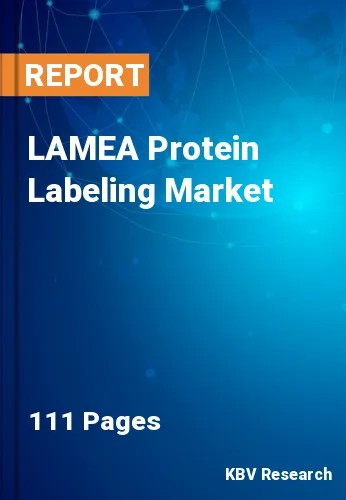The Latin America, Middle East and Africa Protein Labeling Market would witness market growth of 11.7% CAGR during the forecast period (2022-2028).
Appropriate protein labeling techniques would allow probes to be easily placed at any position in any protein articulated in prokaryotic and eukaryotic cells and organisms; fast and quantitative; be precise for a user-defined site in a protein; necessitate no toxic reagents and produce no toxic by-products; exhibit turn-on fluorescence with minimal off-site or background labeling. The genetically encoded, site-specific insertion of unnatural amino acids with bioorthogonal functional groups will allow for the labeling of specific proteins at specified places with almost any probe.
A pyrrolysyl tRNA synthetase/tRNACUA pair variation is generated to genetically encode a set of 1, 2 amino-thiol carrying amino acids in the search for quicker processes for site-specific protein labeling. The cyanobenzothiazole-based probes interact with these amino acids. The tagging of a protein was demonstrated with two distinct probes using this method in combination with cysteine labeling. While the 1, 2 aminothiol generated thiazolidine adducts with aldehydes and ketones in cells, making it unsuitable for in vivo labeling, the procedure allowed protein labeling in an hour with 10 equivalents of the label.
The medical associations and government of the region are highly emphasizing the applications and purpose of the new technology of protein labeling. As per regional medical associations, simple nutrition information should be prominently displayed on the front of food packages as part of an overall strategy to reduce the load of death and disease caused by poor diets. Customers like front-of-pack protein labels, which are more likely to be glanced at or seen than protein labeling on the side or back of packages and can allow consumers better identify healthier and less healthful items. Protein labeling is an uncommon yet developing concept in the Eastern Mediterranean, but governments in a few countries have implemented or are developing three types of schemes.
It is recommended to have several execution pointers for other nations in the region opting to adopt front-of-pack nutrition labeling legislation after reviewing evaluations of available data and evidence from country adoption. Protein labeling has long been regarded as one way to empower customers to make healthier eating choices. Thus, due to the grown emphasis on applications and purpose of protein labeling technology by the regional government and medical associations, the regional market is expected to propel in the forecast period.
The Brazil market dominated the LAMEA Protein Labeling Market by Country in 2021, and would continue to be a dominant market till 2028; thereby, achieving a market value of $60.3 million by 2028. The Argentina market is anticipated to grow at a CAGR of 12.3% during (2022 - 2028). Additionally, The UAE market would showcase a CAGR of 11.4% during (2022 - 2028).
Based on Method, the market is segmented into In-vitro (Enzymatic, Dye-based, Co-translational, Site-specific, Nanoparticle, and Others) and In-vivo (Photoreactive, Radioactive, and Others). Based on Product, the market is segmented into Reagents, Kits, and Services. Based on Application, the market is segmented into Immunological Techniques, Cell-based Assays, Fluorescence Microscopy, Protein Microarray, and Mass Spectrometry. Based on countries, the market is segmented into Brazil, Argentina, UAE, Saudi Arabia, South Africa, Nigeria, and Rest of LAMEA.
Free Valuable Insights: The Global Protein Labeling Market is Predict to reach $3.2 Billion by 2028, at a CAGR of 7.5%
The market research report covers the analysis of key stake holders of the market. Key companies profiled in the report include Thermo Fisher Scientific, Inc., Merck Group, PerkinElmer, Inc., General Electric (GE) Co., F. Hoffmann-La Roche Ltd., Kaneka Corporation, New England BioLabs Inc., Promega Corporation, LI-COR, Inc., and SeraCare Life Sciences.
By Method
By Product
By Application
By Country
Our team of dedicated experts can provide you with attractive expansion opportunities for your business.

